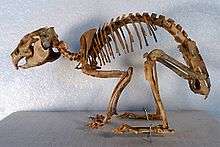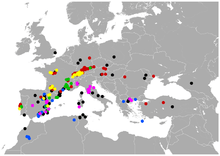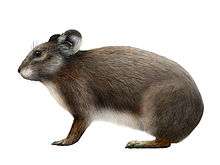Prolagus
Prolagus is an extinct genus of pika within the order of lagomorphs, which also includes the Leporidae (rabbits and hares). It was previously considered a member of the monotonic family Prolagidae.[3]
| Prolagus | |
|---|---|
 | |
| A Prolagus skeleton | |
| Scientific classification | |
| Kingdom: | Animalia |
| Phylum: | Chordata |
| Class: | Mammalia |
| Order: | Lagomorpha |
| Family: | Ochotonidae |
| Genus: | †Prolagus Pomel, 1853 |
| Type species | |
| Prolagus oeningensis König, 1825 | |
| Species | |
|
See text | |
 | |
Prolagus first appeared in the Early Miocene in Europe, where it ranged widely for most of the period, by the Middle Pleistocene it was confined to Sardinia where it survived until historical times. In Africa and Asia, the genus is known from the Miocene and Pliocene.[4] The scientific name may mean "before hares" or "primitive hares" (pro- meaning "before" and lagos meaning "hare").
Species
The genus Prolagus consists of several prehistoric species.[5] Only one, the Sardinian pika (P. sardus), survived to historical times.[6]
- Prolagus aguilari
- Prolagus apricenicus
- Prolagus bilobus[7]
- Prolagus calpensis (Major, 1905)
- Prolagus crusafonti López Martinez 1977
- Prolagus fortis
- Prolagus figaro
- Prolagus imperialis
- Prolagus italicus
- Prolagus major
- Prolagus michauxi
- Prolagus oeningensis König 1825
- Prolagus osmolskae[8]
- Prolagus praevasconiensis
- Prolagus sardus (Wagner, 1832)
- Prolagus schnaitheimensis
- Prolagus sorbinii
- Prolagus tobieni
- Prolagus vasconiensis Viret 1930

Reconstruction of Prolagus sardus
Notes
gollark: I mean, there is precedent for capitalizing words to distinguish them from the more generic version, but that doesn't seem particularly relevant here.
gollark: There's not anything stopping you from writing them in lowercase.
gollark: Not really.
gollark: What we really need, clearly, is formally specified English.
gollark: Fine, I'll stick to standard English then. Mostly.
References
| Wikimedia Commons has media related to Prolagus. |
- Ge, Deyan; Wen, Zhixin; Xia, Lin; Zhang, Zhaoqun; Erbajeva, Margarita; Huang, Chengming; Yang, Qisen (April 3, 2013). "Evolutionary History of Lagomorphs in Response to Global Environmental Change". PLoS ONE. 8 (4:e59668): e59668. doi:10.1371/journal.pone.0059668. PMC 3616043. PMID 23573205. Retrieved May 22, 2014.
Table_S1.xls
- "The Paleobiology Database. †Prolagus Pomel 1853 (pika)". Retrieved 2015-03-05.
- Hoffman, R.S.; Smith, A.T. (2005). "Order Lagomorpha". In Wilson, D.E.; Reeder, D.M (eds.). Mammal Species of the World: A Taxonomic and Geographic Reference (3rd ed.). Johns Hopkins University Press. pp. 193–194. ISBN 978-0-8018-8221-0. OCLC 62265494.
- McKenna, M.C.; Bell, S.K. Classification of Mammals: Above the Species Level. Columbia University Press. p. 109. ISBN 0-231-11013-8.
- Angelone, C. (2004). "Messinian Prolagus (Lagomorpha, Mammalia) of Italy". Messinian Online. Archived from the original on 2012-12-09. Retrieved 2008-01-14.
- Nowak, Ronald M. (1999). Walker's Mammals of the World, 6th edition, volume II. Johns Hopkins University Press. pp. 1936 pp.
- Čermák, S.; Angelone, C. (2013). "Revision of the type material of the Pliocene species Prolagus bilobus Heller, 1936 (Mammalia, Lagomorpha), with comments on the taxonomic validity of P. osmolskae Fostowicz-Frelik, 2010". Bulletin of Geosciences. 88 (1): 45–50. doi:10.3140/bull.geosci.1369.
- Fostowicz-Frelik, Ł (2010). "A new species of Pliocene Prolagus (Lagomorpha, Ochotonidae) from Poland is the northernmost record of the genus". Journal of Vertebrate Paleontology. 30 (2): 609–612. doi:10.1080/02724631003621789.
Additional references of the Paleobiology Database
- Ginsburg, L. (1969). "Le plus ancien morse du Monde". Bulletin du Muséum National d'Histoire Naturelle. 41 (4): 995–998. [M. Uhen/M. Uhen/M. Uhen]
Paleobiology Database: Pontigne 2 (Miocene of France) (les Buissonneaux) - Antunes, M. T.; Mein, P. (1981). "Vertébrés du miocène moyen de amor (Leiria) - importance stratigraphique". Ciências da Terra. 6: 169–188. [J. Mueller/T. Liebrecht/T. Liebrecht]
Paleobiology Database: Amor, point 1 ("premiere gisement" of Zbyszewski)", Amor, points 2 to 5 (Miocene of Portugal) - Buffetaut, E.; Crouzel, F.; Juillard, F.; Stigliani, F. (1984). "Le crocodilien longirostre Gavialosuchus dans le Miocene moyen de Polastron (Gers, France)". Geobios. 17 (1): 113–117. doi:10.1016/s0016-6995(84)80009-1. [P. Mannion/P. Mannion]
Paleobiology Database: Polastron (Miocene of France) - Hoyos, M.; Garcia del Cura, M. A.; Ordonyez Martinez, S. (1981). "Caracteristicas geologicas de yacimiento de los Valles de Fuentiduenya (Segovia)". Estudios Geologicos. 37: 345–351. [A. Turner/H. O'Regan/H. O'Regan]
Paleobiology Database: Nivel X-Fisura, Nivel X, Nivel Y, Los Valles de Fuentiduenya (Segovia) (Miocene of Spain) - Sese Benito, C.; Lopez Martinez, N. (1981). "Los micromammiferos (insectivora, rodentia y lagomorpha) de Vallesiense inferior de Los Valles de Fuentidueña (Segovia, España)". Estudios Geologicos. 37: 369–381. [A. Turner/H. O'Regan/H. O'Regan]
Paleobiology Database: Nivel X-Fisura, Nivel X, Nivel Y, Los Valles de Fuentiduenya (Segovia) (Miocene of Spain) - Heissig, K. (1989). "Neue Ergebnisse zur Stratigraphie der mittleren Serie der Oberen Süßwassermolasse Bayerns (New results on the stratigraphy of the middle series of upper Freshwater Molasse, Bavaria)". Geologica Bavarica. 94: 239–257. [J. Alroy/S. Kuemmell/S. Kuemmell]
Paleobiology Database: Ziemetshausen 1b, 1a (Miocene of Germany) - L. Abbazzi, C. Angelone, M. Arca, G. Barisone, C. Bedetti, M. Delfino, T. Kotsakis, F. Marcolini, M. R. Palombo, M. Pavia, P. Piras, L. Rook, D. Torre, C. Tuveri, A. M. F. Valli and B. Wilkens (2004). "Plio-Pleistocene fossil vertebrates of Monte Tuttavista (Orosei, Eastern Sardinia, Italy), an overview". Rivista Italiana di Paleontologia e Stratigrafia. 110 (3): 681–706.CS1 maint: uses authors parameter (link) [A. Turner/H. O'Regan/H. O'Regan]
Paleobiology Database: Fissure 7, Blocco Strada Quarry (VII bl. St.),Fissure 7, Mustelide Quarry (VII Mustelide),Fissure 6, Quarry 3 (VI 3),Fissure 10, Ghiro Quarry (X Ghiro) (Pliocene of Italy),Fissure 11, Antilope Quarry, (XI antilope),Fissure 6, Banco 6 Quarry, (VI Banco 6),Fissure 7, Quarry 2, (VII 2),Fissure 10, 3 Uccelli Quarry, (X 3 uccelli),Fissure 11, canide Quarry, (XI canide),Fissure 9, Prolagus Quarry, (IX Prolagus),Fissure 11, dic.2001, (XI dic.2001),Fissure 11, Quarry 3, (XI 3),Fissure 11, Rondone Quarry, (XI rondone),Fissure 4, Quarry 5 Prolagus, (IV 5 prol.),Fissure 4, Quarry 20, (IV 20) (Pleistocene of Italy) - Ginsburg, L.; Bonneau, M. (1995). "La succession des faunes de mammiferes miocenes de Pontigne (Maine-et-Loire, France)". Bulletin du Muséum National d'Histoire Naturelle. 4 (2–4): 313–328. [M. Uhen/M. Uhen]Paleobiology Database: [https://paleobiodb.org/cgi-bin/bridge.pl?a=basicCollectionSearch&collection_no=148396 Pontigne 4 (marine) (Miocene of France) (les Buissoneaux)
- Böttcher, R.; Heizmann, E. P. J.; Rasser, M. W; Ziegler, R. (2009). "Biostratigraphy and palaeoecology of a Middle Miocene (Karpathian, MN 5) fauna from the northern margin of the North Alpine Foreland Basin (Oggenhausen 2, SW' Germany)". Neues Jahrbuch für Geologie und Paläontologie, Abhandlungen. 254 (1/2): 237–260. doi:10.1127/0077-7749/2009/0011. [J. Mueller/T. Liebrecht]
Paleobiology Database: Oggenhausen 2 (Miocene of Germany) - Additional contributors to utilized records of Paleobiology Database (authorizers supplying these records) include Johannes Mueller, Philip Mannion, Mark Uhen, John Alroy, Alan Turner.
This article is issued from Wikipedia. The text is licensed under Creative Commons - Attribution - Sharealike. Additional terms may apply for the media files.